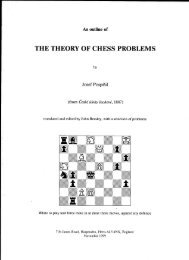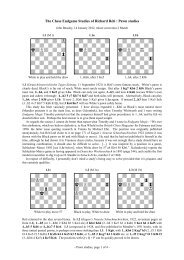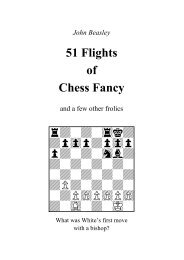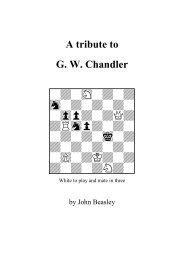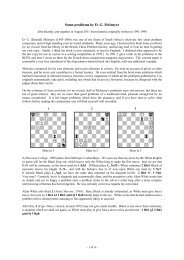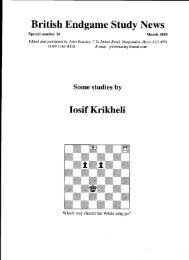The Chess Endgame Studies of Richard Réti - JSB
The Chess Endgame Studies of Richard Réti - JSB
The Chess Endgame Studies of Richard Réti - JSB
Create successful ePaper yourself
Turn your PDF publications into a flip-book with our unique Google optimized e-Paper software.
- <strong>The</strong> chess endgame studies <strong>of</strong> <strong>Richard</strong> <strong>Réti</strong> -<br />
4.8 (M 26) 4.8a 4.8b<br />
wdwdw4wd wdwdwdwd wdwdwdwd<br />
dwdwdwdw dwdwdKdw dwdwdwIw<br />
wdwdw0w0 wdwdwdr0 wdwdwdw0<br />
dwdwdK0k dwdwdwdk dwdwdriw<br />
wdw$wdwd wdwdwdpd Pdwdwdpd<br />
dwdpdwdw dwdpdw)w dwdwdw)w<br />
PdwdwdPd Pdwdwdwd wdwdwdwd<br />
dwdwdwdw dRdwdwdw dRdwdwdw<br />
White to play and win After 5 Kf7 After 9...Kg5<br />
In 4.8 (Tijdschrift v. d. NSB 1922, version in Ostrauer Morgenzeitung, 6 February 1923, dedicated to Dr A.<br />
Mandler), 1 g3 threatens mate by 2 Rh4+ gxh4 3 g4, and the only realistic defence is 1...Rg8 (if instead 1...g4<br />
then 2 Rxg4 and mate by 3 Rh4). Now 2 Rb4 threatens mate by 3 Rb1 and 4 Rh1, and the only defence is<br />
2...g4. White still continues with 3 Rb1, but Black can give himself a little air by 3...Rg5+ 4 Kxf6 Rg6+ 5 Kf7.<br />
This has brought us to 4.8a, and we see that Black is not wholly out <strong>of</strong> the wood; a move by his rook along<br />
the rank will allow Rb5+ and mate next move, and ...Kg5 will allow mate at once. <strong>The</strong>re remains 5...d2, but<br />
6 a4 maintains the pressure (and its guard on b5 will be useful in the later play). Black still has no good rook or<br />
king move, but 6...d1Q 7 Rxd1 gets the pawn <strong>of</strong>f the board, and now 7...Rf6+ has become available because<br />
8 Kxf6 will be stalemate. Hence 8 Kg7, and if 8...Rg6+ then 9 Kh7 leaves Black helpless (he can avoid mate by<br />
9...Kg5 10 Rd5+ Kf6, but 11 Rd6+ then picks up the rook). But Black can play 8...Rf5 claiming the fifth rank<br />
for himself, and after 9 Rb1 Kg5 we have 4.8b.<br />
If now 10 Rb5, which was White’s objective in playing 9 Rb1, Black can reply 10...h5, and he will draw<br />
(11 Rxf5+ Kxf5 12 a5 h4 13 a6 hxg3 etc). <strong>The</strong> winning move is 10 Rb6, and if 10...h5 then 11 Rg6 gives mate.<br />
So Black moves his rook, say 10...Re5, and now White can play 11 Rb5. <strong>The</strong> exchange 11...Rxb5 12 axb5<br />
loses, White being a tempo ahead <strong>of</strong> the previous line, and if he moves his rook back to f5 or defends it by<br />
11...Kf5 White will win by exchanging it <strong>of</strong>f and taking the pawn on h6.<br />
4.9 (M 27) 4.9a 4.9b<br />
rdwdwdwd wdwdwdw4 wdwdwdw4<br />
0pIwdPdP 0pdwdPdP 0wdwdPdP<br />
wdwdwdwd wdwIwdwd wdpdKdwd<br />
dw)wdwdw dw)wdwdw dwiwdwdw<br />
wdwiwdwd wdwiwdwd wdwdwdwd<br />
dwdwdwdw dwdwdwdw dwdwdwdw<br />
Pdwdwdwd Pdwdwdwd Pdwdwdwd<br />
dwdwdwdw dwdwdwdw dwdwdwdw<br />
White to play and win 1 Kd6, after 1...Rh8 4 Ke6, after 4...Kc5<br />
White’s first thought in 4.9 (equal 1st/2nd Prize, Shakhmatny Listok, 1927/I) might be 1 Kxb7 with 2 c6 to<br />
follow, but it is soon seen to be inadequate. 1...Rh8 threatens 2...Rxh7 pinning the f-pawn, if 2 c6 then 2...Rxh7<br />
3 c7 Rxf7 with ...Rxc7 to follow, and if 2 Kc6 to avoid the pin then 2...Ke5 etc.<br />
So White must go the other way, and the natural move is 1 Kd6 guarding the c-pawn and avoiding the pin.<br />
But Black still plays 1...Rh8, and White has a problem (see 4.9a). Given that 2 Ke7 will be met by 2...Rxh7<br />
again pinning the pawn, his only chance appears to be 2 Ke6 going for the rook, but Black will play 2...Kxc5 and<br />
shadow him across: 3 Kf6 Kd6 4 Kg7 Ke7 5 Kxh8 Kxf7. White is now blocked in, and will be stalemated when<br />
his pawn moves have run out. Nor will sacrificing the c-pawn help (2 c6 bxc6 3 Ke6 Kc5 and exactly the same),<br />
and moves by the a-pawn can simply be echoed by Black.<br />
<strong>The</strong> way forward is 1 Kd7, and after 1...Rh8 then 2 Kd6 giving 4.9a with Black to play. 2...Ke4 is clearly<br />
hopeless (3 Ke6 Kd4 4 Kf6 Kd5 5 Kg7 Ke6 6 f8Q), but does not 2...Kc4 3 Ke6 Kxc5 lead to a draw as before?<br />
No, White can meet 2...Kc4 by 3 c6 (now sacrificing the c-pawn does help), and after 3...bxc6 not 4 Ke6,<br />
met by 4...Kc5 as before (see 4.9b), but 4 Ke5. Black must play 4...Kc5 to keep in touch, and 5 Ke6 gives 4.9b<br />
with Black to play. Moves by the a-pawn can be echoed by White, 5...a6 6 a3 a5 7 a4, and after 7...K~ we shall<br />
have 8 Kf6 Kd5 10 Kg7 Ke6 11 f8Q.<br />
It is one <strong>of</strong> <strong>Réti</strong>’s most subtle studies.<br />
- Rooks and pawns, page 5 <strong>of</strong> 5 -



